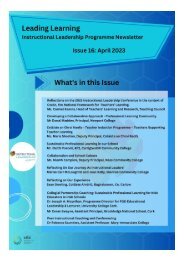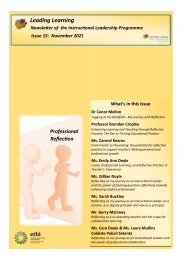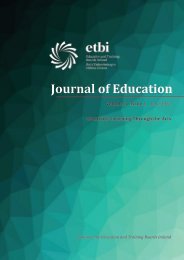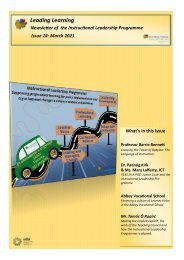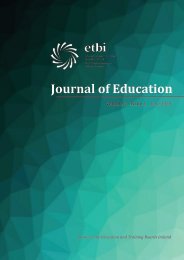ETBI Journal of Education - Vol 2:2 November 2020 (Irish-medium Education)
This bilingual edition of the Journal of Education celebrates Irish-medium Education
This bilingual edition of the Journal of Education celebrates Irish-medium Education
Create successful ePaper yourself
Turn your PDF publications into a flip-book with our unique Google optimized e-Paper software.
<strong>ETBI</strong> <strong>Journal</strong> <strong>of</strong> <strong>Education</strong> <strong>November</strong> <strong>2020</strong><br />
ever since 3 . <strong>Irish</strong>-<strong>medium</strong> schools were in<br />
demand and had community support (Ó Riagáin<br />
agus Ó Gliasaín, 1979; Ó Riagáin, 1997) at a time<br />
when the immersion education system founded<br />
in the early years <strong>of</strong> the state was failing. This<br />
was a movement from the ground up instead<br />
<strong>of</strong> from the top down. This type <strong>of</strong> immersion<br />
education was not only in demand in Ireland,<br />
but also in other regions and countries; Wales,<br />
Catalonia, Hawaii, the Basque Country and New-<br />
Zealand, for example. In these regions, and in<br />
Canadian and American regions where indigenous<br />
languages were spoken (Morcom agus Roy, 2019),<br />
primary and secondary schools were founded to<br />
revitalise the native languages. Several benefits<br />
and challenges are associated with immersion<br />
education which are discussed in the next section<br />
<strong>of</strong> this article.<br />
THE BENEFITS AND CHALLENGES OF NEW<br />
IMMERSION EDUCATION<br />
The benefits <strong>of</strong> immersion education have been<br />
long recognised, particularly in the context <strong>of</strong><br />
minority languages 4 . International research<br />
demonstrates that the immersion education<br />
system develops the academic skills (Baker &<br />
Wright, 2017) and cognitive abilities (Baker &<br />
Wright, 2017) <strong>of</strong> learners. Overall, they have<br />
3 The inception or beginnings <strong>of</strong> this immersion education<br />
was first seen in Canada in 1965, when parents, educators and<br />
researchers undertook a community experiment known as the “St.<br />
Lambert Experiment”(Lambert & Tucker, 1972). The experiment<br />
was highly successful in terms <strong>of</strong> French acquisition.<br />
4 Míníonn García (2009:247): “Motivated by the success<br />
<strong>of</strong> the Canadian immersion bilingual programs, ethnolinguistic<br />
minorities who have experienced language shift away from their<br />
heritage languages have adapted the Canadian model to fit their<br />
needs.”<br />
more developed abilities in their second or target<br />
language (Genesee, 1987). Research tells us that,<br />
on average, a high academic standard is being<br />
achieved by learners in Ireland (for example,<br />
Gilleece et al, 2011) and in other countries (for<br />
example, Genesee & Lindholm-Leary, 2013).<br />
The research indicates that the potential to<br />
acquire a second language is greatly expanded,<br />
without prejudice to the acquisition <strong>of</strong> the first<br />
language (Gilleece et al, 2011). Such research<br />
helps guide practice and attainment in schools<br />
in disadvantaged areas (Ní Chlochasaigh et al,<br />
<strong>2020</strong>).<br />
Despite this, however, several challenges have also<br />
been identified. Although learners in immersion<br />
education succeed in attaining native-like ability<br />
and fluency in their passive abilities (listening<br />
and reading), the same does not appear to be true<br />
for their active abilites (speaking and writing).<br />
Although learners in immersion education <strong>of</strong>ten<br />
achieve a high standard <strong>of</strong> communication in the<br />
second language (Ó Duibhir, 2018), problems<br />
and a lack <strong>of</strong> accuracy can be detected in the<br />
type <strong>of</strong> language (interlanguage) they acquire<br />
in the system, which is heavily influenced by the<br />
structure and syntax <strong>of</strong> the first language. (Ní<br />
Dhiorbháin agus Ó Duibhir, 2017; Ó Ceallaigh,<br />
2016; Walsh, 2007). Today, there is no shortage<br />
<strong>of</strong> innovative, dynamic research being provided<br />
by teachers, who are researchers, which provides<br />
potential guidance and advice for immersion<br />
education teachers to overcome some <strong>of</strong> these<br />
challenges for the benefit <strong>of</strong> learners.<br />
There is another major challenge faced by<br />
immersion education however, relating to<br />
language policy and language revitalisation, which<br />
will be discussed in the next section <strong>of</strong> this article.<br />
PAGE 109




